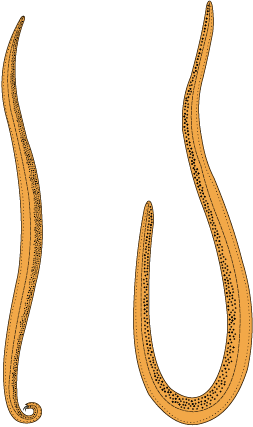The body of the aschelminthes is circular in cross-section, hence, the name roundworms (Figure 4.10). They may be freeliving, aquatic and terrestrial or parasitic in plants and animals. Roundworms have organ-system level of body organisation. They are bilaterally symmetrical, triploblastic and pseudocoelomate animals.

Male Female
Figure 4.10 Example of Aschelminthes: Roundworm
Alimentary canal is complete with a well-developed muscular pharynx. An excretory tube removes body wastes from the body cavity through the excretory pore. Sexes are separate (dioecious), i.e., males and females are distinct. Often females are longer than males. Fertilisation is internal and development may be direct (the young ones resemble the adult) or indirect.
Examples : Ascaris (Roundworm), Wuchereria (Filaria worm), Ancylostoma (Hookworm).

© 2025 GoodEd Technologies Pvt. Ltd.